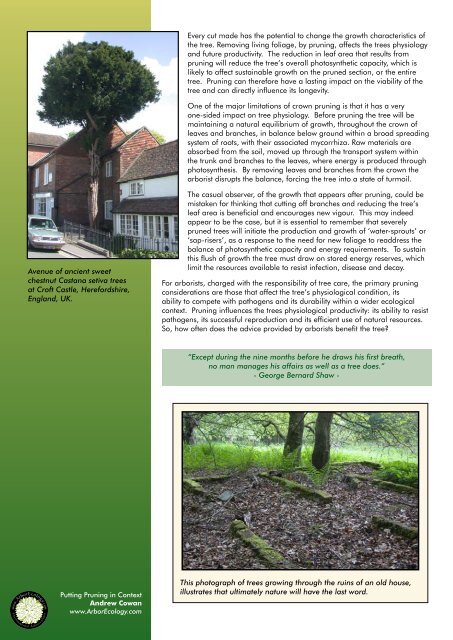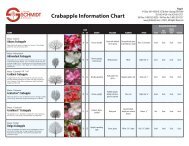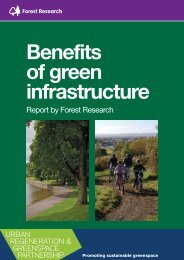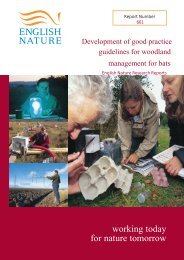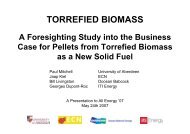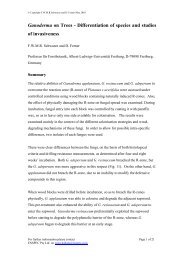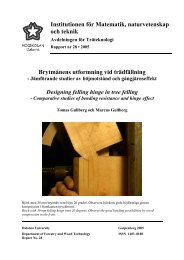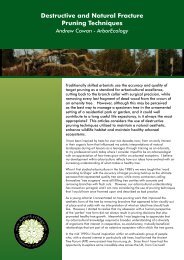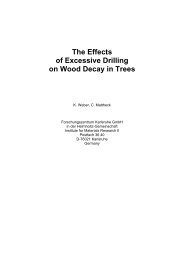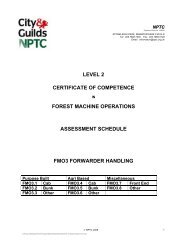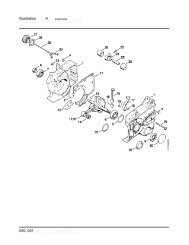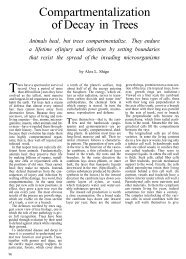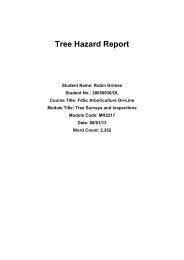Putting Pruning in Context Andrew Cowan - ArborEcology - Arbtalk
Putting Pruning in Context Andrew Cowan - ArborEcology - Arbtalk
Putting Pruning in Context Andrew Cowan - ArborEcology - Arbtalk
- No tags were found...
Create successful ePaper yourself
Turn your PDF publications into a flip-book with our unique Google optimized e-Paper software.
Every cut made has the potential to change the growth characteristics ofthe tree. Remov<strong>in</strong>g liv<strong>in</strong>g foliage, by prun<strong>in</strong>g, affects the trees physiologyand future productivity. The reduction <strong>in</strong> leaf area that results fromprun<strong>in</strong>g will reduce the tree’s overall photosynthetic capacity, which islikely to affect susta<strong>in</strong>able growth on the pruned section, or the entiretree. <strong>Prun<strong>in</strong>g</strong> can therefore have a last<strong>in</strong>g impact on the viability of thetree and can directly <strong>in</strong>fluence its longevity.One of the major limitations of crown prun<strong>in</strong>g is that it has a veryone-sided impact on tree physiology. Before prun<strong>in</strong>g the tree will bema<strong>in</strong>ta<strong>in</strong><strong>in</strong>g a natural equilibrium of growth, throughout the crown ofleaves and branches, <strong>in</strong> balance below ground with<strong>in</strong> a broad spread<strong>in</strong>gsystem of roots, with their associated mycorrhiza. Raw materials areabsorbed from the soil, moved up through the transport system with<strong>in</strong>the trunk and branches to the leaves, where energy is produced throughphotosynthesis. By remov<strong>in</strong>g leaves and branches from the crown thearborist disrupts the balance, forc<strong>in</strong>g the tree <strong>in</strong>to a state of turmoil.Avenue of ancient sweetchestnut Castana setiva treesat Croft Castle, Herefordshire,England, UK.The casual observer, of the growth that appears after prun<strong>in</strong>g, could bemistaken for th<strong>in</strong>k<strong>in</strong>g that cutt<strong>in</strong>g off branches and reduc<strong>in</strong>g the tree’sleaf area is beneficial and encourages new vigour. This may <strong>in</strong>deedappear to be the case, but it is essential to remember that severelypruned trees will <strong>in</strong>itiate the production and growth of ‘water-sprouts’ or‘sap-risers’, as a response to the need for new foliage to readdress thebalance of photosynthetic capacity and energy requirements. To susta<strong>in</strong>this flush of growth the tree must draw on stored energy reserves, whichlimit the resources available to resist <strong>in</strong>fection, disease and decay.For arborists, charged with the responsibility of tree care, the primary prun<strong>in</strong>gconsiderations are those that affect the tree’s physiological condition, itsability to compete with pathogens and its durability with<strong>in</strong> a wider ecologicalcontext. <strong>Prun<strong>in</strong>g</strong> <strong>in</strong>fluences the trees physiological productivity: its ability to resistpathogens, its successful reproduction and its efficient use of natural resources.So, how often does the advice provided by arborists benefit the tree?“Except dur<strong>in</strong>g the n<strong>in</strong>e months before he draws his first breath,no man manages his affairs as well as a tree does.”- George Bernard Shaw -<strong>Putt<strong>in</strong>g</strong> <strong>Prun<strong>in</strong>g</strong> <strong>in</strong> <strong>Context</strong><strong>Andrew</strong> <strong>Cowan</strong>www.<strong>ArborEcology</strong>.comThis photograph of trees grow<strong>in</strong>g through the ru<strong>in</strong>s of an old house,illustrates that ultimately nature will have the last word.


